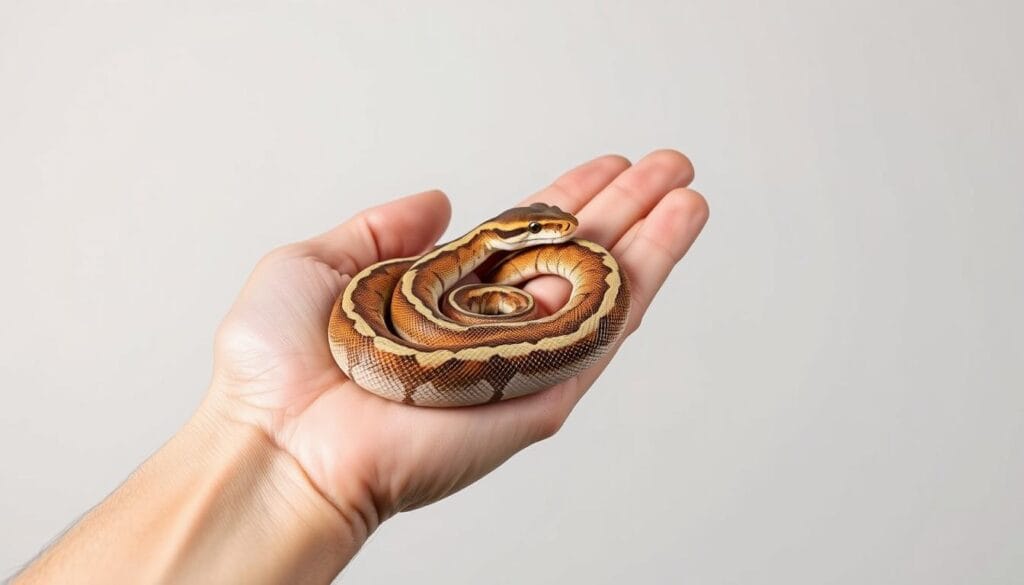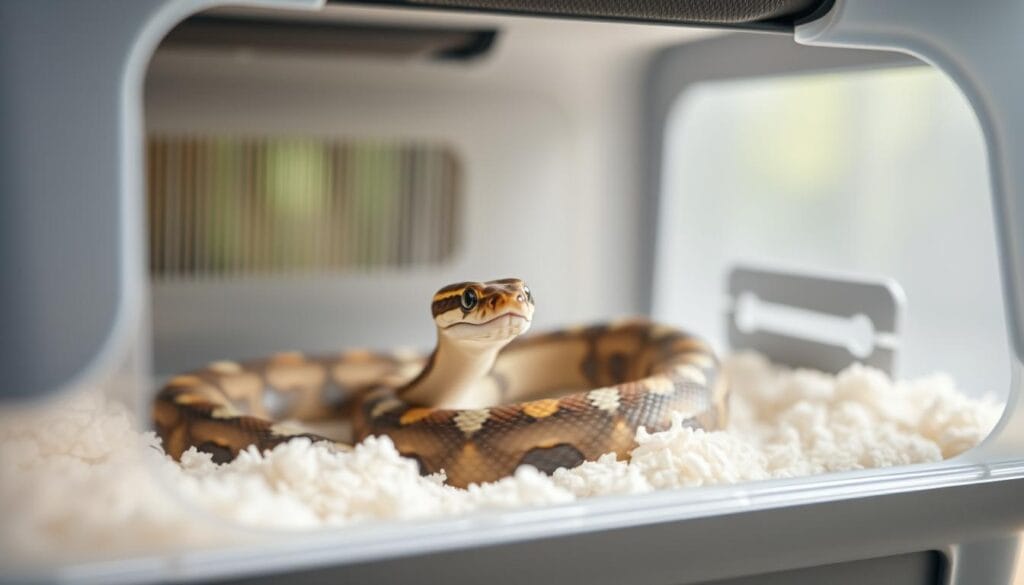Corn snakes are a great choice for reptile lovers. They are gentle and easy to handle. Learning how to handle them well can make your time together more enjoyable.
It’s important to handle your corn snake safely to build trust. Being patient and consistent helps create a positive bond. This makes both you and your snake feel comfortable when you’re together.
Understanding how to handle corn snakes is key. They have their own way of communicating. By learning their signals and responding correctly and the corn snake handling tips, you can connect with them on a deeper level.
Table of Contents
Understanding Corn Snake Behavior
Learning to read corn snake signals takes patience and attention. These reptiles show their feelings through body language. Knowing how to handle them starts with understanding their behavior.
Corn snakes communicate without words. Their body language tells us a lot about their mood. By noticing these signs, you can bond deeply with your pet. This is true for any exotic pet.
Signs of a Comfortable Snake
A happy corn snake shows certain signs. These tell us they feel safe and happy:
- Loose, fluid body posture
- Slow and deliberate movements
- Calm tongue flicking
- Willingness to explore surroundings
- No defensive coiling or striking
How They Communicate
Understanding snake communication is like learning a silent language of subtle gestures and movements.
To pick up a corn snake right, you need to read their body language. They talk through:
- Tongue movements
- Body positioning
- Muscle tension
- Rhythmic breathing patterns
Common Myths about Corn Snakes
Many people think corn snakes are scary. But they’re not aggressive. They’re usually calm and can bond well with their owners.
It’s important to know each snake’s personality. This helps build trust and ensures good interactions. Every corn snake is different, needing patient and careful care.
Preparing for Handling
Creating the right environment is key when handling your pet corn snake. It ensures a safe and comfy experience for both you and your reptile friend. Knowing the basics of corn snake care and handling helps build trust and reduces stress.
- Choose a quiet, calm environment
- Maintain a consistent room temperature between 75-82°F
- Remove potential distractions or hazards
- Wash your hands thoroughly before handling
Selecting the Right Time
Timing is crucial for corn snake care and handling. Snakes are most open to interaction during certain times:
- Avoid handling during shedding
- Wait 48 hours after feeding
- Choose dawn or dusk when snakes are naturally more active
- Ensure the snake appears calm and alert
Creating a Safe Environment
Your handling area should be secure and comfy. Use a flat, stable surface away from sudden movements or loud noises. Keep the space warm and draft-free. A soft, clean surface like a smooth table or padded area is best for handling.
Pro tip: Consistency in your handling environment helps your snake feel secure and builds trust over time.
Remember, each snake is unique. Patience and a gentle approach are essential for successful handling.
Approaching Your Corn Snake
Learning how to approach your corn snake is key to building trust and having a good time together. The best way to handle corn snakes is to understand their behavior and keep the environment calm.
Corn snakes are very friendly, making them great for beginners. They talk to us in their own way through body language. It’s important to watch and respect their signs.
Reading Your Snake’s Body Language
It’s vital to know how your corn snake is feeling. Here are some signs to look out for:
- Relaxed, smooth body posture suggests comfort
- Raised head and tense muscles indicate potential stress
- Tongue flicking shows curiosity and exploration
- Coiling or rapid movement might signal defensive behavior
Steps to a Calm Introduction
Here’s how to introduce yourself to your corn snake:
- Move slowly and deliberately
- Approach from the side, not from above
- Speak softly to help the snake recognize your presence
- Let the snake smell your hand before attempting to touch
- Support the snake’s body when lifting to ensure security
Remember, patience is key when building trust with your corn snake.
By using these tips, you’ll have a great time with your corn snake. Gentle and regular interactions will strengthen your bond.
The Best Handling Techniques
Learning to handle corn snakes well takes patience, understanding, and a gentle touch. It’s important to handle them safely to build trust. This can make your relationship with your snake much better.
Starting with snake handling means knowing your pet’s needs and how they act. You want to make sure they feel safe and calm.
Proper Grip for Safety
When you handle your corn snake, aim for support, not a tight grip. Here are some key tips:
- Gently scoop the snake from underneath
- Support ⅓ to ½ of the snake’s body
- Avoid grabbing or constraining the snake
- Let the snake move naturally through your hands
Keeping Calm and Steady
Your feelings affect your snake’s comfort. Snakes can pick up on your stress. So, it’s important to stay calm.
“Confidence and gentleness are the keys to successful snake handling.” – Reptile Experts
| Handling Technique | Best Practices |
|---|---|
| Hand Position | Support from underneath, avoid top-down approach |
| Handling Frequency | 1-2 times weekly, 10-15 minutes per session |
| Body Support | Cover ⅓ to ½ of snake’s length |
Every corn snake is different. Being patient and gentle will help build trust over time.
Building Trust Over Time
Building a strong bond with your corn snake takes patience and understanding. It’s about creating calm and predictable moments. This helps your snake feel secure and comfortable.
It’s important to avoid stress when handling your snake. Trust grows slowly, needing careful attention to your snake’s comfort and behavior.
Creating Positive Handling Experiences
Effective handling of corn snakes involves a few key steps:
- Start with short sessions lasting 10-15 minutes
- Handle your snake only 2-3 times per week
- Always approach slowly and predictably
- Support the snake’s entire body during interaction
Recognizing Stress Signals
“A calm snake is a happy snake” – Reptile Handling Experts
Learn to spot stress signs in your corn snake:
- Hissing or striking
- Excessive hiding
- Unusual restlessness
- Loss of appetite
By recognizing these signs and acting on them, you build a safe space. Your snake will feel secure and happy during handling.
Handling Young versus Adult Corn Snakes

Caring for corn snakes needs different methods based on their age. Knowing the special traits of hatchlings and adult snakes helps. This knowledge is key to picking up a snake correctly and handling them well.
Corn snakes change a lot as they grow. They can live 15-25 years. This means you’ll see many changes in how to handle them.
Unique Considerations for Hatchlings
Young corn snakes need extra care. Their small size and soft body require special handling:
- Handle for shorter periods (5-10 minutes)
- Support their entire body when lifting
- Move slowly and predictably
- Avoid handling immediately after feeding
Juvenile corn snakes are more flexible and can escape more easily, so always maintain careful supervision during interactions.
Techniques for Adult Snakes
Adult corn snakes, usually 3-5 feet long, need different handling:
- Use a confident, steady grip
- Allow more extended handling sessions
- Recognize their increased strength and stability
- Support their body weight more firmly
Patience is key, no matter the age. Give your snake time to get used to being handled. Watch for signs of stress and respect their mood.
Handling After Feeding
Caring for a corn snake means watching how it eats and digests. Knowing when to handle your snake after it eats is key. It keeps your snake healthy and avoids digestive problems.
Timing is crucial when handling corn snakes. After eating, your snake needs time to digest. It should not be stressed or disturbed.
Importance of Waiting
Experts say don’t handle your corn snake for 48-72 hours after it eats. This waiting is important because:
- Handling too soon can cause regurgitation
- Digestive processes are sensitive during this time
- Stress can interrupt the snake’s natural metabolic functions
Signs Your Snake is Ready
Knowing when your corn snake is ready for handling involves watching for certain signs:
- Complete digestion (usually 2-3 days post-feeding)
- Normal body posture
- Active and alert behavior
- No visible bulge from recent meal
By following these guidelines, you’ll keep your pet healthy and happy. It ensures they are comfortable and stress-free during feeding and handling times.
Travel and Transportation Tips

Traveling with your corn snake needs careful planning. As a beginner, knowing how to safely transport your snake is crucial. It ensures your pet stays comfortable and safe.
When traveling with your corn snake, there are key things to remember. These tips help keep your reptile safe and reduce stress during trips.
Preparing Your Snake for Travel
Before you go, focus on a few important steps for snake transportation:
- Check your snake’s health with a vet
- Choose the right travel container
- Keep the right temperature and humidity
- Handle your snake less during travel
Essential Travel Container Requirements
| Characteristic | Recommended Specification |
|---|---|
| Container Material | Sturdy, escape-proof plastic |
| Ventilation | Multiple small air holes |
| Temperature Range | 70-85 degrees Fahrenheit |
| Humidity Level | 50-70% |
Ensuring a Safe Journey
When traveling with your corn snake, remember these important tips:
- Travel during cooler parts of the day
- Use heating packs for stable temperatures
- Avoid sudden movements or temperature changes
- Watch for signs of stress in your snake
Pro tip: For air travel, check specific airline regulations regarding pet snake transportation, as requirements can vary significantly.
Safety first: Always prioritize your corn snake’s comfort and well-being during any transportation.
Troubleshooting Common Handling Issues
Handling corn snakes can sometimes be tricky, even for experienced owners. It’s important to handle them safely to avoid stress and escapes. Knowing your snake’s personality helps make handling stress-free.
When your corn snake acts defensively, it’s not being aggressive. It’s just reacting to threats. Handling them gently and patiently is key to avoiding stress.
Dealing with Defensive Behavior
Defensive corn snakes show several warning signs:
- Rapid body coiling
- Hissing sounds
- Striking without biting
- Musking (releasing a foul-smelling liquid)
Experts suggest using a snake hook to calm your snake. It keeps you safe while guiding the snake.
Managing Escape Artists
Some corn snakes are more curious and prone to exploring. To stop them from escaping:
- Always handle snakes in a secure, enclosed space
- Move slowly and predictably
- Support the snake’s entire body
- Keep handling sessions short initially
Building trust with your snake takes time. Gentle, consistent handling helps them feel more comfortable. This reduces defensive behavior and escape attempts.
Regular Care Post-Handling
After handling your corn snake, it’s important to keep up with its care. Corn snake handling tips and care need attention to your snake’s needs. Watch how your snake acts and looks after each time you handle it.
Cleanliness is crucial for handling corn snakes. Clean the enclosure every day by removing waste and dirty substrate. Do a deep clean once a month to keep the habitat healthy. Also, check your snake’s skin for any issues during this time.
Keep an eye on your snake’s appetite, behavior, and health. Look out for signs of stress like hiding too much, eating less, or moving differently. Regular health checks include weighing, skin checks, and watching for behavior changes. If you see anything odd, talk to a reptile vet for advice.
Consistent, gentle care helps build a strong bond with your corn snake. By focusing on post-handling care, you’ll keep your snake healthy, happy, and trusting of you.

